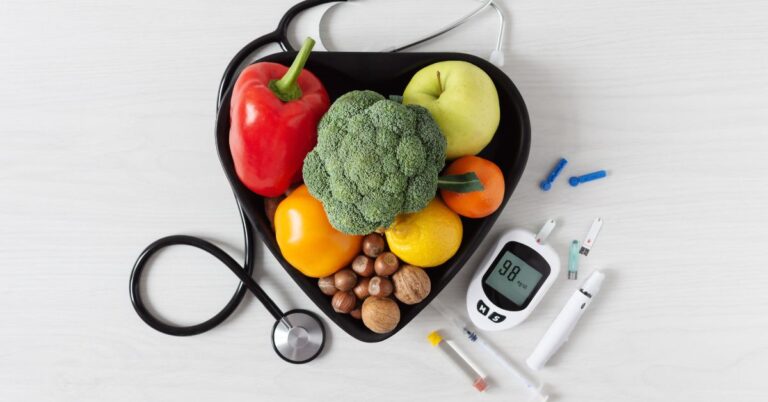Losing weight and managing blood sugar levels can feel like an uphill battle, especially if you’ve tried countless diets without seeing lasting results. For those who are using Ozempic, the journey doesn’t have to be a struggle. This powerful medication is known for its ability to control blood sugar and reduce appetite, but its benefits can be significantly amplified with the right diet plan.
In this guide, we’ll show you how to create an effective eating plan tailored to your health goals, helping you achieve steady weight loss while supporting balanced blood sugar levels. Whether you’re new to Ozempic or simply looking to maximize its effects, these practical tips and meal ideas will set you on the path to success.
Let’s dive into a sustainable approach that fits seamlessly into your lifestyle, empowering you to reach your healthiest self.
Understanding Ozempic Diet Plan and Its Benefits
Ozempic is an injectable prescription medication primarily used to help individuals with type 2 diabetes manage their blood sugar levels. The active ingredient in Ozempic is semaglutide, which belongs to a class of drugs known as GLP-1 (glucagon-like peptide-1) receptor agonists. This medication works by mimicking the effects of the GLP-1 hormone that your body naturally produces in response to eating.
The Importance of an Ozempic Diet Plan for Weight Loss
While Ozempic can significantly aid in weight loss and blood sugar control, its full potential is best realized when combined with a balanced diet. Relying solely on the medication may yield some results, but the impact can be amplified when paired with healthy eating habits. Here’s why a tailored diet plan is crucial:
- Enhances Weight Loss: By focusing on nutrient-dense, low-calorie foods, you can maximize Ozempic’s appetite-suppressing effects. Eating high-protein meals, healthy fats, and fiber-rich vegetables helps you stay fuller longer, reducing the urge to overeat.
- Stabilizes Blood Sugar: A balanced diet that prioritizes whole grains, lean proteins, and non-starchy vegetables can help prevent blood sugar spikes and crashes, making it easier for Ozempic to do its job effectively.
- Boosts Energy Levels: When you fuel your body with the right nutrients, you’ll have more energy throughout the day. This can enhance your overall well-being and support a more active lifestyle, which in turn aids weight loss.
- Promotes Sustainable Habits: Creating a meal plan that aligns with Ozempic’s effects encourages healthier eating habits that you can maintain long-term. This approach not only supports weight loss but also helps you keep it off for good.
What Your Ozempic Diet Plan Should Include
To get the best results while using Ozempic, focus on eating foods that support weight loss and keep your blood sugar stable. Here’s a simple breakdown of what your diet should have:
- Lean Proteins: These help you feel full and keep your blood sugar steady. Good options include chicken, fish, eggs, tofu, and beans.
- Lots of Vegetables: Go for non-starchy veggies like spinach, kale, broccoli, zucchini, and bell peppers. They are low in carbs but packed with nutrients.
- Healthy Fats: Healthy fats help you feel satisfied. Include foods like avocados, olive oil, nuts, seeds, and fatty fish like salmon.
- Whole Grains (in moderation): If you eat carbs, choose whole grains like brown rice, quinoa, or oats, which are healthier and digest slowly.
Sample 7-Day Ozempic Meal Plan for Weight Loss
Looking for a simple way to kickstart your weight loss journey with Ozempic? This 7-day meal plan is designed to complement the medication’s effects, helping you stay full, manage cravings, and keep blood sugar levels steady. With balanced, easy-to-prepare meals, you’ll be set up for success all week long.
Day 1
Breakfast: Greek Yogurt & Berry Bowl
- Ingredients: You’ll need 1 cup of unsweetened Greek yogurt, ¼ cup of mixed berries (like blueberries and raspberries), 1 tablespoon of chia seeds, and a sprinkle of cinnamon.
- Preparation: In a bowl, combine the yogurt and berries. Top with chia seeds and a dash of cinnamon. Stir lightly if preferred, or leave layered for added texture. Enjoy immediately for a refreshing, protein-rich start to your day.
Lunch: Grilled Chicken Salad
- Ingredients: Gather 4 oz grilled chicken breast, 2 cups mixed greens (spinach, arugula), ½ avocado (diced), 5 cherry tomatoes (halved), 1 tablespoon each of olive oil and lemon juice, plus salt and pepper.
- Preparation: Season the chicken with salt and pepper, then grill for 6-8 minutes per side until fully cooked. Let rest, then slice. In a bowl, combine greens, avocado, and tomatoes. Add chicken slices, drizzle with olive oil and lemon juice, and toss gently. Serve fresh.
Dinner: Baked Salmon with Asparagus
- Ingredients: You’ll need a 6 oz salmon fillet, 1 cup asparagus spears (trimmed), 1 teaspoon olive oil, salt, pepper, and an optional teaspoon of lemon zest.
- Preparation: Preheat the oven to 400°F (200°C). Place salmon and asparagus on a parchment-lined baking sheet. Drizzle with olive oil, season with salt, pepper, and lemon zest if desired. Bake for 15-20 minutes until salmon is flaky and asparagus is tender. Serve hot.
Snack: Raw Almonds
- Ingredients: Measure out ¼ cup of raw almonds.
- Preparation: Simply enjoy a handful of almonds as a quick, healthy snack to keep you energized between meals. No prep required.
Day 2
Breakfast: Scrambled Eggs & Spinach
- Ingredients: For this nutrient-packed breakfast, you’ll need 2 large eggs, 1 cup of fresh spinach leaves, ¼ avocado (sliced), and a pinch of salt and pepper.
- Preparation: Heat a non-stick pan over medium heat. Add the spinach and sauté for about a minute until wilted. In a bowl, whisk the eggs with a pinch of salt and pepper, then pour into the pan. Stir gently to scramble until cooked through but still soft. Serve with avocado slices on the side for a nutritious, filling start to your day.
Lunch: Tuna Salad Lettuce Wraps
- Ingredients: You’ll need one can (5 oz) of tuna packed in water (drained), 1 tablespoon of Greek yogurt, 1 tablespoon each of diced celery and red onion, a pinch of salt and pepper, and several large Romaine lettuce leaves.
- Preparation: In a mixing bowl, combine the drained tuna with Greek yogurt, celery, and red onion. Season with salt and pepper to taste. Spoon the mixture into Romaine lettuce leaves to create wraps. This low-carb lunch is light, refreshing, and easy to prepare.
Dinner: Garlic Shrimp Stir-Fry
- Ingredients: Gather 6 oz of shrimp (peeled and deveined), 1 cup of broccoli florets, 1 red bell pepper (thinly sliced), 1 tablespoon coconut oil, 1 teaspoon minced garlic, and 1 teaspoon grated fresh ginger.
- Preparation: Heat coconut oil in a large skillet over medium heat. Add garlic and ginger, cooking until fragrant (about 1 minute). Add the shrimp, broccoli, and bell pepper slices. Stir-fry for 5-6 minutes, or until the shrimp are pink and the vegetables are tender-crisp. Serve hot for a satisfying, nutrient-dense dinner.
Snack: Carrot Sticks & Hummus
- Ingredients: You’ll need 1 cup of carrot sticks and 2 tablespoons of hummus.
- Preparation: Simply serve the carrot sticks with a side of hummus for a crunchy, fiber-rich snack that’s perfect for keeping hunger at bay between meals.
Day 3
Breakfast: Chia Seed Pudding
- Ingredients: To make this healthy breakfast, gather 3 tablespoons of chia seeds, 1 cup unsweetened almond milk, 3-4 sliced strawberries, and 1 tablespoon chopped almonds.
- Preparation: Combine the chia seeds and almond milk in a bowl or jar, stirring well. Refrigerate overnight to allow the chia seeds to absorb the liquid and form a pudding-like consistency. In the morning, top with fresh strawberries and chopped almonds for a nutritious, fiber-rich breakfast.
Lunch: Turkey & Avocado Wrap
- Ingredients: You’ll need 4 oz of sliced turkey breast, 1 whole-grain tortilla, ½ avocado (mashed), and a handful of mixed greens.
- Preparation: Lay the whole-grain tortilla flat and spread the mashed avocado over it. Layer the turkey slices and mixed greens on top. Roll the tortilla tightly into a wrap. Slice in half and enjoy a balanced, protein-rich lunch.
Dinner: Baked Chicken Thighs & Cauliflower Rice
- Ingredients: Gather 2 bone-in chicken thighs, 1 cup cauliflower rice, 1 tablespoon olive oil, and seasonings (salt, pepper, paprika).
- Preparation: Preheat your oven to 375°F (190°C). Season the chicken thighs with salt, pepper, and paprika, then place them on a baking sheet. Bake for 25-30 minutes, or until the internal temperature reaches 165°F (74°C). While the chicken cooks, heat olive oil in a skillet over medium heat and sauté the cauliflower rice for about 5 minutes. Serve the chicken alongside the cauliflower rice.
Snack: Apple & Peanut Butter
- Ingredients: 1 small apple and 1 tablespoon natural peanut butter.
- Preparation: Slice the apple into wedges and enjoy with a dollop of peanut butter for a satisfying snack that balances sweetness and protein.
Day 4
Breakfast: Overnight Oats
- Ingredients: You’ll need ½ cup rolled oats, 1 cup unsweetened almond milk, 1 scoop protein powder, and ¼ cup blueberries.
- Preparation: In a bowl or jar, combine oats, almond milk, and protein powder. Stir thoroughly, cover, and refrigerate overnight. In the morning, top with fresh blueberries for a quick, nutrient-dense breakfast.
Lunch: Grilled Tofu Stir-Fry
- Ingredients: Gather 4 oz firm tofu (cubed), 1 cup mixed veggies (zucchini, carrots, snap peas), and 1 tablespoon low-sodium soy sauce.
- Preparation: Heat a non-stick skillet over medium-high heat. Add the tofu and stir-fry until golden brown. Add the mixed veggies and soy sauce, cooking for another 5-7 minutes until the vegetables are tender. Serve hot for a satisfying plant-based meal.
Dinner: Zucchini Noodles with Turkey Meatballs
- Ingredients: 4 oz ground turkey, 1 cup marinara sauce (low-sugar), 1 zucchini (spiralized).
- Preparation: Form the ground turkey into small meatballs and bake at 375°F (190°C) for 20 minutes. In a separate skillet, heat the marinara sauce and add the meatballs once cooked. Toss with spiralized zucchini noodles until well coated. Serve hot.
Snack: Mixed Nuts
- Ingredients: ¼ cup mixed nuts (unsalted).
- Preparation: Portion out the mixed nuts for a healthy snack that’s rich in healthy fats and protein.
Day 5
Breakfast: Green Smoothie
- Ingredients: Combine 1 cup unsweetened almond milk, a handful of spinach, 1 scoop protein powder, ¼ cup frozen berries, and 1 tablespoon ground flaxseed.
- Preparation: Blend all ingredients until smooth. Pour into a glass and enjoy a refreshing, nutrient-packed start to your day.
Day 6
Breakfast: Cottage Cheese & Peaches
- Ingredients: You’ll need 1 cup of cottage cheese, ½ cup of sliced peaches (fresh or canned in juice, drained), and a sprinkle of cinnamon.
- Preparation: In a bowl, combine the cottage cheese with the sliced peaches. Sprinkle a dash of cinnamon on top for added flavor. Enjoy this protein-packed, refreshing breakfast that keeps you full throughout the morning.
Lunch: Lentil Soup & Side Salad
- Ingredients: Gather 1 cup of cooked lentil soup, 2 cups of mixed greens, 1 tablespoon of olive oil, 1 tablespoon of balsamic vinegar, and salt and pepper for seasoning.
- Preparation: Warm up the lentil soup on the stove or in the microwave. For the salad, toss mixed greens with olive oil, balsamic vinegar, salt, and pepper. Serve the hot soup alongside the fresh salad for a nutritious, fiber-rich meal.
Dinner: Grilled Lamb Chops & Mashed Cauliflower
- Ingredients: You’ll need 2 small lamb chops, 1 cup of cauliflower florets, 1 tablespoon olive oil, salt, pepper, and a pinch of rosemary.
- Preparation: Season the lamb chops with salt, pepper, and rosemary. Grill them for 4-5 minutes on each side or until desired doneness. For the cauliflower mash, steam the cauliflower until tender, then blend with olive oil, salt, and pepper until smooth. Serve hot.
Snack: Boiled Egg
- Ingredients: 1 large egg and a pinch of salt.
- Preparation: Hard-boil the egg, peel, and sprinkle with a little salt. Enjoy as a quick, protein-rich snack to keep you energized between meals.
Day 7
Breakfast: Veggie Omelet
- Ingredients: Gather 2 eggs, ¼ cup each of chopped bell peppers, onions, and mushrooms, and a pinch of salt and pepper.
- Preparation: Whisk the eggs with salt and pepper. In a non-stick skillet, sauté the chopped veggies until soft, then pour the eggs over them. Cook until set, folding in half. Serve warm for a hearty breakfast.
Lunch: Baked Salmon Patties & Coleslaw
- Ingredients: 4 oz canned salmon (drained), 1 egg, ¼ cup almond flour, 1 tablespoon Dijon mustard, salt, pepper, and 1 cup coleslaw mix with 2 tablespoons Greek yogurt for dressing.
- Preparation: Mix the salmon, egg, almond flour, mustard, salt, and pepper. Form into patties and bake at 375°F (190°C) for 15-20 minutes, until golden. For the coleslaw, combine the mix with Greek yogurt. Serve the salmon patties with a side of coleslaw.
Dinner: Chicken & Veggie Stir-Fry
- Ingredients: 4 oz chicken breast (sliced), 1 cup mixed veggies (bok choy, carrots, bell peppers), 1 tablespoon low-sodium soy sauce, 1 teaspoon olive oil, and a pinch of garlic powder.
- Preparation: Heat olive oil in a pan over medium heat. Add chicken and cook until browned. Add mixed veggies, soy sauce, and garlic powder. Stir-fry for 5-7 minutes until veggies are tender-crisp. Serve hot.
Snack: Pumpkin Seeds
- Ingredients: ¼ cup pumpkin seeds (unsalted).
- Preparation: Simply portion out the pumpkin seeds for a crunchy, nutrient-dense snack to enjoy between meals.
Tips to Maximize Weight Loss While on Ozempic
Incorporate Regular Physical Activity:
Aim for at least 30-45 minutes of exercise most days of the week. Activities like brisk walking, cycling, or strength training can help boost metabolism, support muscle tone, and enhance fat burning. Consistent movement also improves insulin sensitivity, which is crucial for managing blood sugar levels.
Stay Hydrated:
Drinking plenty of water is essential for weight loss. Water helps flush out toxins, supports digestion, and can even reduce hunger by keeping you feeling full. Aim to drink at least 8-10 glasses daily. Consider starting your day with a glass of water and keeping a refillable bottle nearby as a reminder.
Try Intermittent Fasting:
A 16:8 intermittent fasting schedule—where you eat within an 8-hour window and fast for 16 hours—can align well with Ozempic’s appetite-suppressing effects. This approach can help control calorie intake and improve fat metabolism without feeling overly deprived. For example, have your first meal at 11 a.m. and finish dinner by 7 p.m.
Manage Stress Effectively:
Chronic stress can lead to overeating and weight gain due to elevated cortisol levels, which can trigger cravings for high-calorie foods. Practice stress-reducing activities like meditation, deep breathing exercises, yoga, or even short walks outdoors to keep stress in check and support your weight loss efforts.
Prioritize Quality Sleep:
Aim for 7-8 hours of uninterrupted sleep each night. Poor sleep disrupts hormones that regulate hunger, leading to increased cravings and a slower metabolism. Establish a calming bedtime routine, such as reading or listening to soft music, to improve your sleep quality.
Common Pitfalls and How to Avoid Them
Skipping Meals or Fasting Too Aggressively:
While intermittent fasting can be helpful, skipping meals entirely can slow your metabolism and cause energy crashes. It may also trigger overeating later in the day. Stick to balanced, nutrient-dense meals during your eating window to maintain steady energy levels.
Overeating Healthy Foods:
While foods like avocados, nuts, and olive oil are healthy, they are also calorie-dense. Eating them in excess can stall weight loss. Be mindful of portion sizes—even with healthier options—and consider using measuring cups or food scales if needed.
Inconsistent Routines on Busy Days:
It’s easy to fall off track when life gets hectic. Prepare healthy snacks like boiled eggs, nuts, or cut veggies to have on hand, especially during busy workdays or travel. When dining out, choose grilled, steamed, or roasted options over fried foods.
Relying Solely on Ozempic:
While Ozempic can help suppress appetite and control blood sugar, it’s not a magic bullet. Its effects are maximized when combined with a balanced diet, regular physical activity, and a healthy lifestyle. Focus on whole foods—lean proteins, vegetables, healthy fats, and moderate whole grains—to see lasting results.
Ignoring Hydration:
Dehydration is often mistaken for hunger, leading to unnecessary snacking. Make it a habit to drink water before meals and throughout the day. If plain water feels boring, try adding slices of lemon, cucumber, or mint for a refreshing twist. Consistent hydration not only aids weight loss but also keeps your metabolism and energy levels steady.
Conclusion: Making the Most of Your Ozempic Diet Plan
Using Ozempic can be a game-changer for weight loss and blood sugar management, but its full potential is best realized when combined with healthy habits. By following a balanced diet, staying active, and making lifestyle adjustments, you can enhance the benefits of this medication.
This guide has equipped you with strategies to optimize your results, whether through tailored meal plans, intermittent fasting, or mindful lifestyle changes. Remember, consistency and flexibility are key—listen to your body, make gradual adjustments, and celebrate non-scale victories along the way.
Success with Ozempic isn’t about quick fixes but building sustainable habits. By staying patient and adaptable, you’ll set yourself up for lasting health and wellness. Stick with it, and the results will follow!










